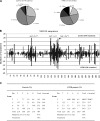Disparate roles of ATR and ATM in immunoglobulin class switch recombination and somatic hypermutation
- PMID: 16390936
- PMCID: PMC2118080
- DOI: 10.1084/jem.20050595
Disparate roles of ATR and ATM in immunoglobulin class switch recombination and somatic hypermutation
Erratum in
- J Exp Med. 2006 Jan 23;203(1):251
Abstract
Class switch recombination (CSR) and somatic hypermutation (SHM) are mechanistically related processes initiated by activation-induced cytidine deaminase. Here, we have studied the role of ataxia telangiectasia and Rad3-related protein (ATR) in CSR by analyzing the recombinational junctions, resulting from in vivo switching, in cells from patients with mutations in the ATR gene. The proportion of cells that have switched to immunoglobulin (Ig)A and IgG in the peripheral blood seems to be normal in ATR-deficient (ATRD) patients and the recombined S regions show a normal "blunt end-joining," but impaired end joining with partially complementary (1-3 bp) DNA ends. There was also an increased usage of microhomology at the mu-alpha switch junctions, but only up to 9 bp, suggesting that the end-joining pathway requiring longer microhomologies (> or =10 bp) may be ATR dependent. The SHM pattern in the Ig variable heavy chain genes is altered, with fewer mutations occurring at A and more mutations at T residues and thus a loss of strand bias in targeting A/T pairs within certain hotspots. These data suggest that the role of ATR is partially overlapping with that of ataxia telangiectasia-mutated protein, but that the former is also endowed with unique functional properties in the repair processes during CSR and SHM.
Figures



Similar articles
-
ATM is not required in somatic hypermutation of VH, but is involved in the introduction of mutations in the switch mu region.J Immunol. 2003 Apr 1;170(7):3707-16. doi: 10.4049/jimmunol.170.7.3707. J Immunol. 2003. PMID: 12646636
-
Immunoglobulin class switch recombination is impaired in Atm-deficient mice.J Exp Med. 2004 Nov 1;200(9):1111-21. doi: 10.1084/jem.20041074. Epub 2004 Oct 25. J Exp Med. 2004. PMID: 15504820 Free PMC article.
-
Non-homologous end joining in class switch recombination: the beginning of the end.Philos Trans R Soc Lond B Biol Sci. 2009 Mar 12;364(1517):653-65. doi: 10.1098/rstb.2008.0196. Philos Trans R Soc Lond B Biol Sci. 2009. PMID: 19008195 Free PMC article. Review.
-
A role for the MutL mismatch repair Mlh3 protein in immunoglobulin class switch DNA recombination and somatic hypermutation.J Immunol. 2006 May 1;176(9):5426-37. doi: 10.4049/jimmunol.176.9.5426. J Immunol. 2006. PMID: 16622010 Free PMC article.
-
DNA targets of AID evolutionary link between antibody somatic hypermutation and class switch recombination.Adv Immunol. 2009;101:163-89. doi: 10.1016/S0065-2776(08)01005-5. Adv Immunol. 2009. PMID: 19231595 Review.
Cited by
-
Phenotypic variations between affected siblings with ataxia-telangiectasia: ataxia-telangiectasia in Japan.Int J Hematol. 2009 Nov;90(4):455-462. doi: 10.1007/s12185-009-0408-0. Epub 2009 Aug 25. Int J Hematol. 2009. PMID: 19705055
-
Replication stress, microcephalic primordial dwarfism, and compromised immunity in ATRIP deficient patients.J Exp Med. 2025 May 5;222(5):e20241432. doi: 10.1084/jem.20241432. Epub 2025 Mar 3. J Exp Med. 2025. PMID: 40029331
-
A regulatory role for NBS1 in strand-specific mutagenesis during somatic hypermutation.PLoS One. 2008 Jun 25;3(6):e2482. doi: 10.1371/journal.pone.0002482. PLoS One. 2008. PMID: 18575580 Free PMC article.
-
ATR kinase supports normal proliferation in the early S phase by preventing replication resource exhaustion.Nat Commun. 2023 Jun 19;14(1):3618. doi: 10.1038/s41467-023-39332-5. Nat Commun. 2023. PMID: 37336885 Free PMC article.
-
Early B-cell-specific inactivation of ATM synergizes with ectopic CyclinD1 expression to promote pre-germinal center B-cell lymphomas in mice.Leukemia. 2015 Jun;29(6):1414-24. doi: 10.1038/leu.2015.41. Epub 2015 Feb 13. Leukemia. 2015. PMID: 25676421 Free PMC article.
References
-
- Lieber, M.R., Y. Ma, U. Pannicke, and K. Schwarz. 2003. Mechanism and regulation of human non-homologous DNA end-joining. Nat. Rev. Mol. Cell Biol. 4:712–720. - PubMed
-
- Muramatsu, M., K. Kinoshita, S. Fagarasan, S. Yamada, Y. Shinkai, and T. Honjo. 2000. Class switch recombination and hypermutation require activation-induced cytidine deaminase (AID), a potential RNA editing enzyme. Cell. 102:553–563. - PubMed
-
- Di Noia, J., and M.S. Neuberger. 2002. Altering the pathway of immunoglobulin hypermutation by inhibiting uracil-DNA glycosylase. Nature. 419:43–48. - PubMed
-
- Rada, C., G.T. Williams, H. Nilsen, D.E. Barnes, T. Lindahl, and M.S. Neuberger. 2002. Immunoglobulin isotype switching is inhibited and somatic hypermutation perturbed in UNG-deficient mice. Curr. Biol. 12:1748–1755. - PubMed
-
- Petersen-Mahrt, S.K., R.S. Harris, and M.S. Neuberger. 2002. AID mutates E. coli suggesting a DNA deamination mechanism for antibody diversification. Nature. 418:99–103. - PubMed
Publication types
MeSH terms
Substances
Grants and funding
LinkOut - more resources
Full Text Sources
Other Literature Sources
Research Materials
Miscellaneous

